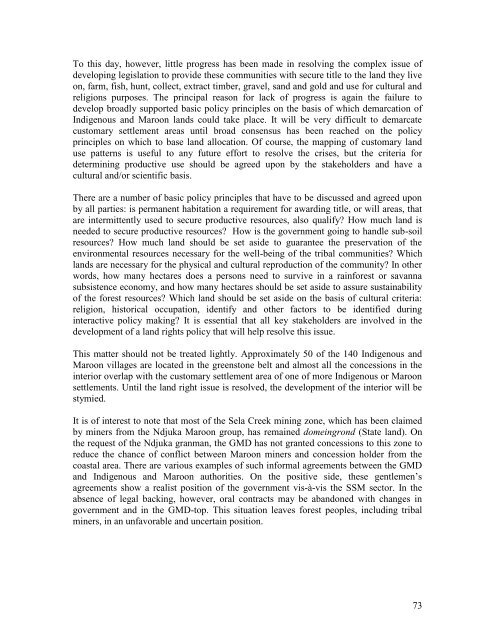SITUATION ANALYSIS OF THE SMALL-SCALE GOLD ... - WWF
SITUATION ANALYSIS OF THE SMALL-SCALE GOLD ... - WWF
SITUATION ANALYSIS OF THE SMALL-SCALE GOLD ... - WWF
Create successful ePaper yourself
Turn your PDF publications into a flip-book with our unique Google optimized e-Paper software.
To this day, however, little progress has been made in resolving the complex issue of<br />
developing legislation to provide these communities with secure title to the land they live<br />
on, farm, fish, hunt, collect, extract timber, gravel, sand and gold and use for cultural and<br />
religions purposes. The principal reason for lack of progress is again the failure to<br />
develop broadly supported basic policy principles on the basis of which demarcation of<br />
Indigenous and Maroon lands could take place. It will be very difficult to demarcate<br />
customary settlement areas until broad consensus has been reached on the policy<br />
principles on which to base land allocation. Of course, the mapping of customary land<br />
use patterns is useful to any future effort to resolve the crises, but the criteria for<br />
determining productive use should be agreed upon by the stakeholders and have a<br />
cultural and/or scientific basis.<br />
There are a number of basic policy principles that have to be discussed and agreed upon<br />
by all parties: is permanent habitation a requirement for awarding title, or will areas, that<br />
are intermittently used to secure productive resources, also qualify? How much land is<br />
needed to secure productive resources? How is the government going to handle sub-soil<br />
resources? How much land should be set aside to guarantee the preservation of the<br />
environmental resources necessary for the well-being of the tribal communities? Which<br />
lands are necessary for the physical and cultural reproduction of the community? In other<br />
words, how many hectares does a persons need to survive in a rainforest or savanna<br />
subsistence economy, and how many hectares should be set aside to assure sustainability<br />
of the forest resources? Which land should be set aside on the basis of cultural criteria:<br />
religion, historical occupation, identify and other factors to be identified during<br />
interactive policy making? It is essential that all key stakeholders are involved in the<br />
development of a land rights policy that will help resolve this issue.<br />
This matter should not be treated lightly. Approximately 50 of the 140 Indigenous and<br />
Maroon villages are located in the greenstone belt and almost all the concessions in the<br />
interior overlap with the customary settlement area of one of more Indigenous or Maroon<br />
settlements. Until the land right issue is resolved, the development of the interior will be<br />
stymied.<br />
It is of interest to note that most of the Sela Creek mining zone, which has been claimed<br />
by miners from the Ndjuka Maroon group, has remained domeingrond (State land). On<br />
the request of the Ndjuka granman, the GMD has not granted concessions to this zone to<br />
reduce the chance of conflict between Maroon miners and concession holder from the<br />
coastal area. There are various examples of such informal agreements between the GMD<br />
and Indigenous and Maroon authorities. On the positive side, these gentlemen‟s<br />
agreements show a realist position of the government vis-à-vis the SSM sector. In the<br />
absence of legal backing, however, oral contracts may be abandoned with changes in<br />
government and in the GMD-top. This situation leaves forest peoples, including tribal<br />
miners, in an unfavorable and uncertain position.<br />
73
















